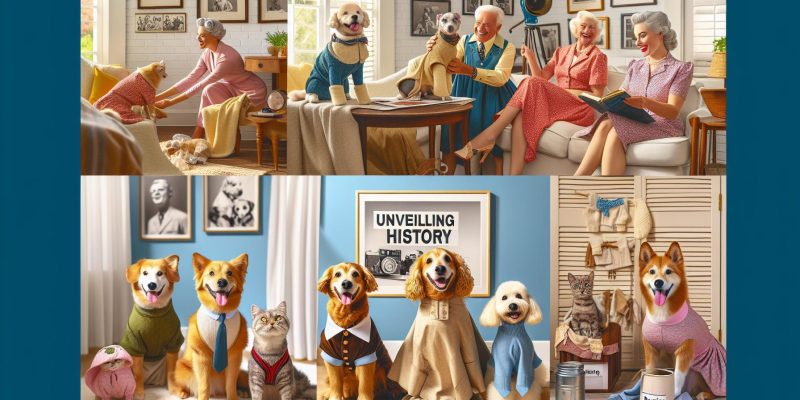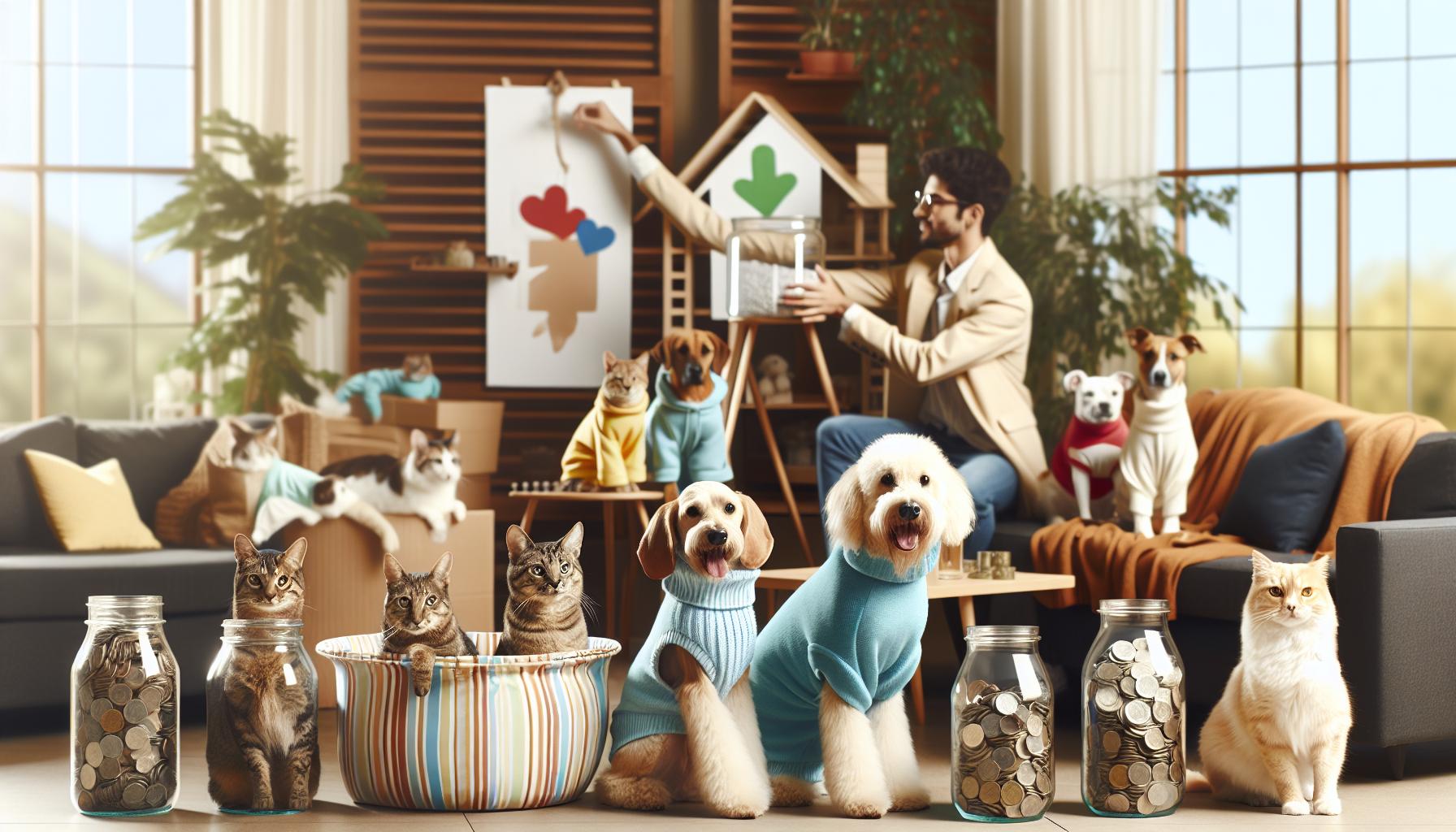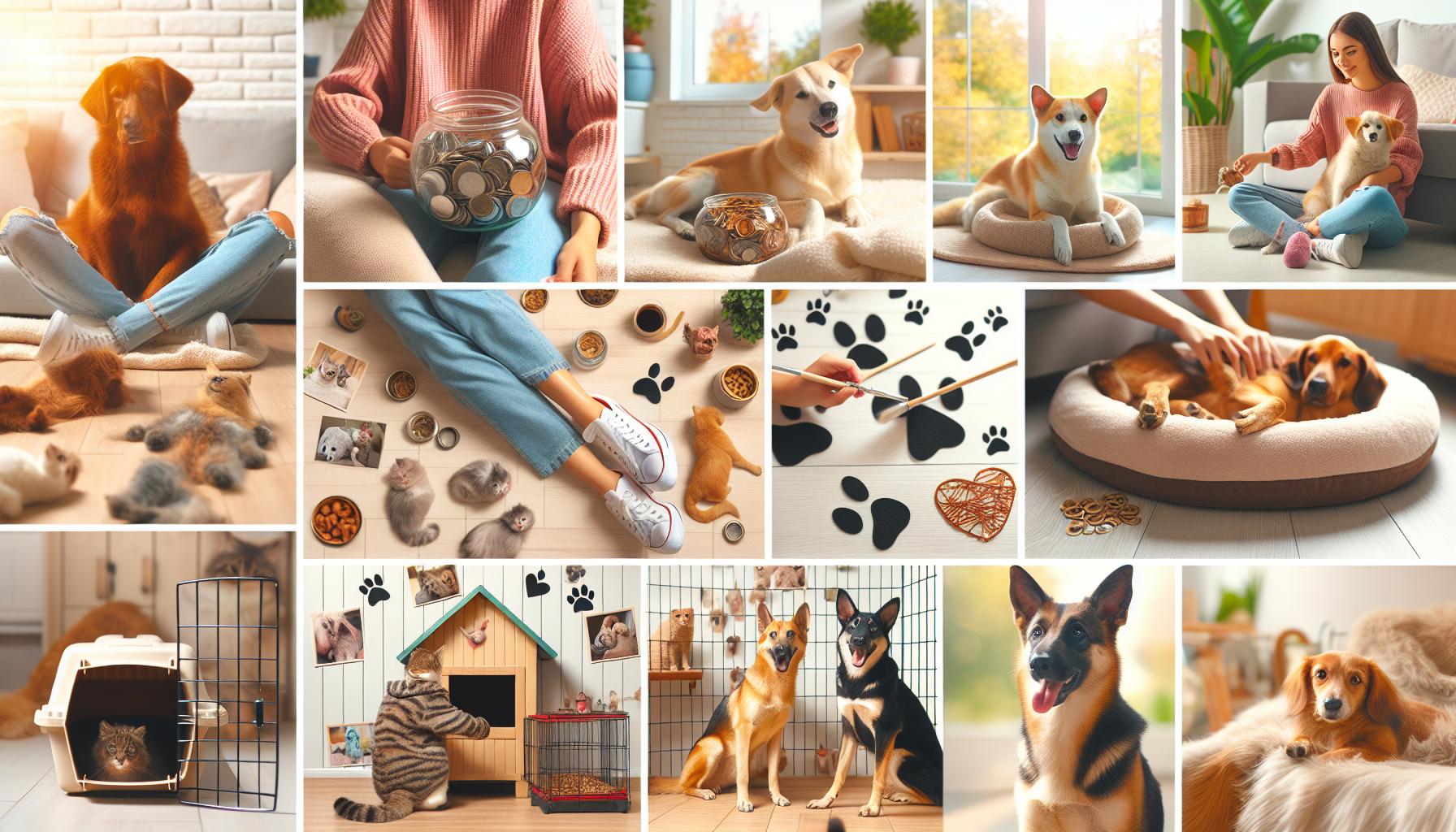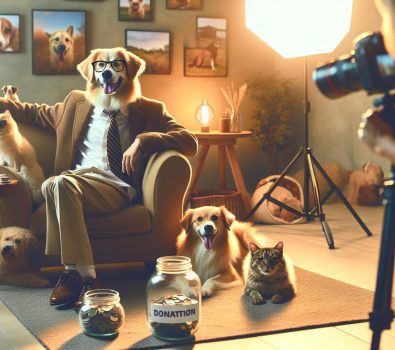Ladies and gentlemen, fashion enthusiasts and pet lovers alike, prepare to embark on a delightful journey through time in our upcoming article, “What Pet Was a Famous fashion Model in the 1940s? Unveiling History.” You might think that the glamour of the runway is reserved for supermodels and haute couture, but in the 1940s, it wasn’t just two-legged beings strutting their stuff. Oh no, one notably fabulous pet turned heads and made waves in the fashion world, proving that style knows no species! Join us as we unravel the tale of this four-legged fashion icon, whose influence still echoes in the collars of canines and the hearts of fashionistas today. Get ready to be amused,amazed,and perhaps inspired to dress your own pet in haute couture!
What Pet Became a Fashion Icon in the 1940s
The Rise of the Scottie Dog as a Fashion Icon
In the 1940s, one pet emerged as a beloved fashion symbol: the Scottish Terrier, or the Scottie Dog. This breed was not just a companion; it became synonymous with elegance and charm. Known for their distinctive silhouette and stylish demeanor, Scotties were often seen accompanying high-profile figures, making them a staple in the fashionable circles of the time.
Public Figures and Scotties
One of the most famous Scottie Dogs was Fala, who belonged to President Franklin D. Roosevelt.Fala’s appearances alongside the President in various public engagements solidified the breed’s status as a fashionable pet. The Scottie Dog’s polished image was further enhanced through its association with the elite, showcasing a blend of playfulness and sophistication that captured the public’s heart.
Fashion Influence and Popularity
Scotties featured prominently in popular media and merchandise during this era. They were frequently depicted in advertisements, illustrations, and even fashion shows, signifying their impact on 1940s culture. Their charm was irresistible; fashion designers drew inspiration from their aesthetic, leading to the creation of accessories that highlighted the elegance of these dogs.
Cultural Impact
- Celebrity Endorsements: Many stars adopted Scotties, driving their image into the mainstream.
- Merchandising: The Scottie inspired everything from prints on clothing to motifs in home decor.
- Social Status: Owning a Scottie became a sign of prestige and stylishness, making it highly sought after.
The Rise of Pets in the Fashion Industry
The Glamorous Poodle: A 1940s Fashion Icon
In the 1940s, one of the most famous pets that took the fashion world by storm was none other than the poodle. Renowned for their elegant appearance and refined demeanor,poodles quickly became the go-to pets for many celebrities and fashion enthusiasts. Their intrinsic flair not only captivated the public but also earned them a spot as beloved models in various fashion advertisements and magazine spreads.
Poodles in Fashion shows
These fashionable canines made waves at fashion shows, parading alongside designers and showcasing exquisite pet apparel. The spotlight on poodles was a pivotal moment that illustrated the growing trend of integrating pets into high fashion. With their groomed coats and stylish accessories, these pets became symbols of luxury and refinement.
Famous Poodles of the Era
- Mocha: A poodle who graced several covers of pet fashion magazines.
- Chloe: Featured in runway shows, captivating audiences with her posh outfits.
- Rex: Acclaimed for stunning looks in jewelry ads designed specifically for pets.
The Legacy of Poodles in Fashion
The influence of 1940s poodles paved the way for the current rise of pets in the fashion industry.Today,we see an increasing number of brands catering to pet fashionistas,offering everything from chic clothing to premium grooming products. This trend not only enhances the bond between pets and their owners but also fuels a global thankfulness for pet fashion, proving that style knows no bounds.
Exploring the Unique Partnership Between Pets and Fashion
The Rise of Pets in Fashion
Throughout history, pets have played significant roles not only as companions but also as cultural icons. One unique aspect of this partnership is their presence in the fashion industry. In the 1940s, a notable figure emerged: a glamorous little dog named Fifi, who sashayed down runways and graced magazine covers, captivating audiences and fashion designers alike.
Fifi: The Four-Legged Fashionista
Fifi, a Maltese, was more than just a pet; she was a phenomenon. Her striking looks and poised demeanor turned her into a beloved model for high-end fashion brands. Designers created exclusive outfits for her, treating fifi as a muse, which further bridged the gap between pets and luxury fashion. This unique collaboration introduced the idea that pets could embody style and sophistication.
Fifi’s Impact on Pet Fashion
- Inspiration for Pet Clothing: Fifi’s influence led to the growth of fashionable pet clothing lines.
- Celebrity Status: She became a pop culture sensation, appearing in various media outlets.
- New Market Opportunities: This event created a niche for luxury pet apparel brands.
The Legacy Continues
The legacy of pets like Fifi continues to inspire today’s fashion trends. Modern pet owners are eager to dress their furry friends in stylish apparel, echoing the sentiments of Fifi’s era. Today’s market offers an array of chic options that reflect current styles while ensuring comfort for pets. As animal companions become integral to fashion narratives, the partnership between pets and fashion remains vibrant and essential.
| Key Elements | Impact |
|---|---|
| Celebrity Pets | Increased demand for fashionable pet clothing. |
| Fashion Shows | Integration of pets in mainstream fashion events. |
| Luxury Brands | Emergence of high-end pet apparel lines. |
Unveiling the Most Famous Pet Models of the Era
The Iconic Star: Laika
One of the most notable pet models of the 1940s was Laika, a stray dog from Moscow who became the frist living creature to orbit Earth.Although her journey into space took place in 1957, Laika’s story captured the world’s creativity in the 1940s as she represented a breakthrough in human and animal collaboration. Laika’s image was embraced in fashion, symbolizing innovation and the intersection of science and art. Her journey highlighted the glamorous allure of the Space Age, which began to influence fashion trends.
Fashion Influence
Laika wasn’t just a scientific marvel; her presence inspired designers to incorporate more daring styles in their collections. The way her story interconnected with the fervor of 1940s fashion showcased the period’s duality of optimism and the severe backdrop of war. Designers, looking for inspiration, found in Laika a muse, embracing elements of surrealism mixed with practicality, as pet models became symbols of progressive thinking.
| Feature | Description |
|---|---|
| Origin | Moscow, USSR |
| Role | First dog in space |
| Year of Launch | 1957 |
| Fashion Impact | Inspired futuristic designs |
Legacy in Fashion
The legacy of Laika and her impact on the fashion world endured beyond her historic flight. She represented the spirit of determination and innovation that resonated within the fashion industry. Her story paved the way for a broader acceptance of animals as fashion icons, leading to trends where pets were frequently enough seen on runways and in marketing campaigns. The love for pets grew, correlating with an increased visibility of animals in elite fashion circles, illustrating a burgeoning relationship between fashion design and animal advocacy.
Lessons from the past: How Pets Influence Modern Fashion
The Iconic Fashion Model: A Look Back
In the glamorous world of the 1940s, one pet stood out as a trailblazer in fashion: the Chihuahua. This petite breed became a prominent companion of Hollywood stars, effortlessly making its way into high society and fashion magazines. With its stylish appearances alongside famous celebrities, the chihuahua captivated hearts and set trends that influenced both pet apparel and human fashion of the time.
Chihuahuas in the Spotlight
Chihuahuas caught the limelight, making waves not only for their adorable size but also for their charming outfits. Celebrity pet owners dressed their dogs in elegant garments, showcasing how pet fashion could complement and enhance their own looks. The influence was significant, paving the way for modern pet fashion industries focused on creating high-quality, stylish apparel.
Key Influences on Modern Fashion
| Influence | Description |
|---|---|
| Designer Collaborations | Modern designers frequently create collections inspired by ancient pet fashion trends, incorporating styles reflective of the 1940s. |
| Fashion Shows | Pets now walk runways in high-end fashion shows, blending pet and human fashion in a unique showcase of style. |
| Social Media Trends | Today’s influencers often highlight stylish pets, perpetuating the blend of pet and human fashion on platforms like Instagram. |
The Evolution of Pet Apparel
As we embrace the legacy of the fashionable Chihuahua from the 1940s, it’s clear that pets continue to inspire modern fashion. The desire for stylish pet clothing has blossomed into a booming industry, with countless brands offering everything from chic dog dresses to sophisticated accessories. This evolution not only reflects the importance of pets in our lives but also encourages a lifestyle where pets are celebrated as integral parts of style and self-expression.
Practical Tips to Incorporate Your Pet into Fashion Trends
Embrace Sustainable Materials
Incorporating your pet into the latest fashion trends starts with choosing environmentally amiable materials. Look for pet outfits crafted from sustainable fabrics such as organic cotton or recycled polyester.These materials not only enhance your pet’s style but also reflect a commitment to eco-conscious living. By selecting products made from sustainable sources, you contribute positively to the planet while keeping your furry friend fashionable.
Utilize Technology in Pet Fashion
As noted in emerging trends, the integration of technology into pet fashion is becoming increasingly popular. Consider investing in smart collars equipped with GPS or health trackers that can be stylishly represented in your pet’s wardrobe. This not only adds a tech-savvy element to their style but also ensures their safety and well-being. Position your pet as a trendsetter with these innovative accessories!
Coordinate Looks with Your Pet
One of the most delightful ways to blend your fashion sense with your pet’s attire is to coordinate outfits. Choose matching colors or complementary styles to create a cohesive look for both you and your pet. For an added touch, select patterned fabric that highlights both of your personalities. This can turn your daily walks into a fashion statement and elevate your social media presence!
Engage in Seasonal Trends
Stay updated with seasonal pet fashion trends that resonate with your aesthetic.For instance, during warmer months, opt for breathable materials and shining colors, while cozy layers are perfect for cooler climates. Planning for seasonal changes not only keeps your pet cozy but also allows you to showcase their style year-round. Make sure to participate in themed events and social media challenges to keep the fun alive!
Celebrate Your Style: How to Make Your Pet a Fashion Star
The Rise of Stylish Pets in the 1940s
During the 1940s, pets made a significant mark in the world of fashion, highlighting the growing trend of pet clothing. One of the most iconic pets of this era was none other than Gigi the Poodle. This elegant dog graced magazine covers and was frequently enough seen as a symbol of glamour and sophistication. Gigi wore a range of stylish outfits, showcasing a seamless blend of fashion and functionality.
Gigi’s Fashion Impact
Gigi’s influence on pet fashion extended beyond mere aesthetics. Pet owners began to recognize that dressing their pets not only elevated their pets’ appearance but also contributed to the overall personality they wanted to portray. This trend created a market for fashionable pet clothing, with many brands emerging to cater to this newfound demand.
Key Features of 1940s Pet Fashion
- Material Variety: Fabrics like wool and cotton were favored for warmth and style.
- Design Elements: Many outfits featured embroidery and embellishments, making pets look chic.
- Color Palettes: Muted tones complemented the classic styles of the era.
The Legacy of Pet Fashion
Today, the legacy of pets like Gigi continues to inspire modern pet fashion, with countless collections available for pet enthusiasts. Brands now offer everything from elegant dresses to cozy sweaters, ensuring that every pet can express their unique style. Embrace this trend by exploring the latest in pet fashion, and let your furry friend shine as the fashion star they deserve to be!
| Feature | Gigi’s Era | Modern trends |
|---|---|---|
| fashion Focus | Classy and Elegant | Trendy and Diverse |
| Materials | Wool, Cotton | Bamboo, Synthetics |
| Availability | Limited Collections | Wide Retail Options |
Frequently asked questions
What pet was renowned as a fashion model during the 1940s?
During the 1940s, the Dachshund, affectionately known as the “Wiener Dog,” became a significant symbol of fashion. The breed’s unique shape and playful demeanor captured the hearts of many, making it a fashionable choice among celebrities and the general public alike. Dachshunds were often seen accompanying their stylish owners, which contributed to their status in the fashion world.
The Dachshund’s popularity during this era can be attributed to several high-profile figures who embraced the breed as part of their public image. This popularity not just reflected the breed’s charm but also highlighted the merging of pet ownership with personal branding. It gave rise to an aesthetic where dogs were accessorized to match their owner’s fashion sense,solidifying the dachshund’s role as a fashionable companion.
Why did Dachshunds become a fashion icon in the 1940s?
Dachshunds achieved fashion icon status in the 1940s due to their unique appearance and personality traits that resonated with the style sensibilities of the time. With their elongated bodies and short legs,they exhibited a fun and quirky look that aligned well with the emerging trends in fashion,which often leaned towards the playful and whimsical.
Additionally, their presence in popular culture, particularly through films and magazines, significantly contributed to their status. Dachshunds frequently appeared alongside glamorous celebrities, which served to elevate their profile. The breed was also commonly featured in photography, showing off chic accessories like collars and coats, further intertwining their image with high fashion.This era saw a transformation in pet ownership, making it less about utility and more about lifestyle and status.
How were Dachshunds depicted in fashion magazines and advertisements?
Fashion magazines and advertisements of the 1940s frequently enough used Dachshunds as visual symbols of elegance and luxury. These dogs were commonly featured in various editorials, showcasing owners in stunning outfits with their pet by their side, reinforcing the idea that having a stylish dog was an extension of one’s fashion statement.
Moreover, these advertisements not only highlighted the Dachshund itself but also integrated it into broader lifestyle portrayals. This technique helped market luxury products by associating them with the aspirational lifestyle of pet owners who embraced fashion. The Dachshund’s adorable appearance complemented the sleek styles of the period, making these promo images not only captivating but also memorable.
What role did celebrities play in the rise of fashionable pet ownership?
Celebrities played a pivotal role in the rise of fashionable pet ownership during the 1940s. Many prominent figures, including actresses and designers, were often seen walking their Dachshunds on the streets of fashionable neighborhoods. This visibility showcased the Dachshund not merely as a pet but as an essential companion in the world of fashion.
These well-placed endorsements provided a significant boost to the Dachshund’s reputation. When noted icons like Brigitte Bardot, known for her love of animals, became synonymous with the breed, it encouraged their acceptance into elite social circles. The media capitalized on these celebrity trends, developing a narrative that combined style with animal companionship, which profoundly influenced public perceptions and aspirations regarding pet ownership.
How did the adoption of pets like Dachshunds reflect societal changes in the 1940s?
The adoption of pets like Dachshunds in the 1940s reflected several crucial societal changes. Post-war sentiments brought families closer together, and pets became part of a newfound emphasis on domesticity and companionship. As individuals sought comfort following the turbulence of the war, animals provided emotional support, making them increasingly popular as family members.
Additionally, the era marked a shift in how society viewed pets—not merely as livestock or utilitarian animals but as companions and fashion statements.The Dachshund’s charming persona resonated with the public,aligning with the burgeoning media culture that showcased personal branding and lifestyle choices. This change in perception facilitated the rise of pet-centric commerce, leading to a market that catered specifically to fashionable pet ownership.
What lasting impact did the Dachshund have on fashion and pet culture?
The legacy of the Dachshund as a fashion model in the 1940s has had a lasting impact on both fashion and pet culture, influencing how dogs are perceived and treated today. The era set a precedent for the integration of animals into fashionable lifestyles, establishing a bond where pets became extensions of personal identity and style.
This phenomenon paved the way for numerous pet fashion industries, from designer pet clothing to specialized pet accessories. Today, many dog owners continue to emulate the fashionable pet ownership model established in the 40s, often incorporating their pets into their personal branding efforts on social media and in daily life. The Dachshund’s sparkle in the fashion scene has undeniably laid a foundation for the modern celebration of pets as fashionable companions.
to sum up
Conclusion: Embracing the Legacy of 1940s Fashion Pets
In reflecting on the charming and unique role that pets played in the glamorous world of 1940s fashion, we uncover not just a historical trivia but a delightful insight into the lifestyles of a bygone era. The iconic fashion models of that time were not solely human—some were four-legged companions that captured the hearts of the public and became symbols of style and elegance.
As we unveil this intriguing history,we encourage you to appreciate the intersection of fashion and the joy that pets bring into our lives.Whether through photographs or vintage campaigns, the legacy of these fashionable pets endures, illustrating that the allure of companionship and chic style is timeless.
Want to dive deeper into the glamorous world of 1940s fashion? Explore more captivating stories, and don’t forget to share your thoughts! Your engagement makes our journey through history even more meaningful. Together, let’s celebrate the past and its charming connections to our present!






